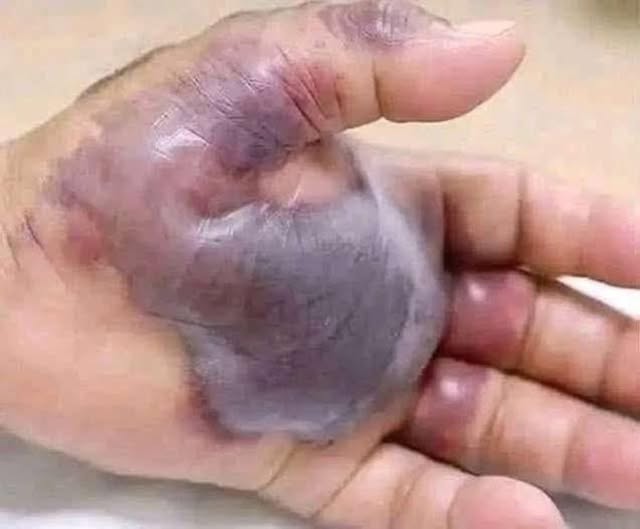ATTENTION to these first signs of!
What started as a faint sting turned into one of the most disturbing medical emergencies a person can face. At first, it looked like nothing — a tiny bite, maybe a scratch, the kind of thing most people wouldn’t even clean properly before moving on with their day. But within hours, the situation spiraled so violently out of control that doctors later said the man was lucky to be alive.
By mid-afternoon, his hand had ballooned to twice its normal size, pulsing with pain so sharp it made him nauseous. The skin, which had first been red and irritated, began to darken — shifting from a bruised purple to a stark, terrifying black. That was the moment he realized he wasn’t dealing with a simple bite. Something inside his body was turning against him, and fast.
When he finally reached the hospital, doctors mobilized immediately. The swelling, the rapid discoloration, the speed at which the tissue was breaking down — none of it pointed to a normal infection. This was something aggressive, something that spreads hour by hour, not day by day.
The medical team began their tests, and the list of possibilities wasn’t comforting. It could have been the venom from a dangerous spider or insect, which can cause severe necrosis and tissue destruction if not treated almost immediately. But another possibility loomed even larger: necrotizing fasciitis, more commonly known as flesh-eating bacteria.
It’s a rare infection, but when it appears, its progression is brutal. The bacteria infiltrate the deep layers of tissue beneath the skin, spreading along muscle fibers, destroying healthy fat and muscle as they go. Without swift intervention, it can overpower the body’s defenses and cause catastrophic damage. In some cases, amputation becomes the only option to save a patient’s life.
By the time surgeons examined his hand, the tissue damage was already significant. Doctors moved quickly, administering powerful IV antibiotics and preparing for emergency surgery to remove the sections of tissue that were already dying. He was lucky — he reached help just before the infection breached the threshold where amputation or worse would have been inevitable.
The photo that later circulated online — the one showing his swollen hand, the skin cracked and darkened — became a harsh lesson for thousands of people who stumbled upon it. A reminder that the body doesn’t always give gentle warnings. Sometimes the danger erupts quickly, violently, without hesitation. And waiting “to see if it gets better” can be the riskiest choice you make.
Situations like this don’t come out of nowhere. They start with small signals that something isn’t right. Signals people often ignore.
Swelling that seems disproportionate to the injury. A sudden spike in pain. Skin changing colors — deep red, purple, or black patches spreading faster than seems reasonable. Blisters forming. A fever that comes out of nowhere. A growing sense of being overwhelmingly unwell. These are not the normal steps of healing.
Doctors warn that the biggest problem isn’t the infection itself — it’s the hesitation. People downplay their symptoms, assuming they’re overreacting. They convince themselves they don’t need help. And by the time they arrive in the emergency room, precious hours have passed, hours that could have kept the situation under control.
If this man had waited until morning, he might not have needed just one surgery — he might have needed several. He might have lost his hand. He might not have survived at all.
This story isn’t meant to scare for the sake of scare tactics. It’s meant to inform. It’s meant to shift the mindset from “It’ll probably be fine” to “Let’s let a professional decide.” Medical complications don’t always announce themselves gently. They don’t wait for your schedule to open up. They advance whether you’re ready or not.
Small wounds — bites, scratches, punctures — can become dangerous if bacteria enter the tissue. And while most heal without a problem, it’s the rare, fast-moving infections that catch people off-guard. Being cautious isn’t weakness. It’s awareness. It’s survival.
The man in the story survived because he paid attention at the last possible moment. He couldn’t ignore the pain anymore. He couldn’t deny the blackening skin. He took action, and that action saved his hand — and probably his life.
But here’s the uncomfortable truth: many people wouldn’t have gone in that quickly. Many people would have taken painkillers, wrapped the hand, gone to bed, and hoped tomorrow looked better. Many people wouldn’t have recognized the urgency until it was too late.
That’s why stories like this matter. They teach us what to look for:
Rapid swelling — not subtle, but dramatic and increasing by the hour.
Pain that feels wildly disproportionate to the injury.
Skin turning red, then dark purple, then black.
Warmth, throbbing, and spreading tenderness.
Blisters, pus, or streaks running up the limb.
Fever, chills, dizziness, or feeling suddenly weak.
If symptoms escalate quickly, you don’t wait. You go.
Most emergencies don’t start with dramatic injuries. They start small — exactly like this one did. Awareness is the difference between early intervention and irreversible damage.
The takeaway is simple: trust your body when something feels wrong, especially when symptoms change rapidly. Don’t rationalize away severe swelling or darkening skin. Don’t give an aggressive infection the chance to advance while you hope it resolves overnight.
You get one life, one body, and one chance to protect it when things take a sudden turn.
If this story does anything, let it be this: the next time your instincts tell you something is wrong, listen — and act. It might be nothing. Or it might save your life.
Stay aware. Stay cautious. And never ignore the warning signs your body is trying to show you.




